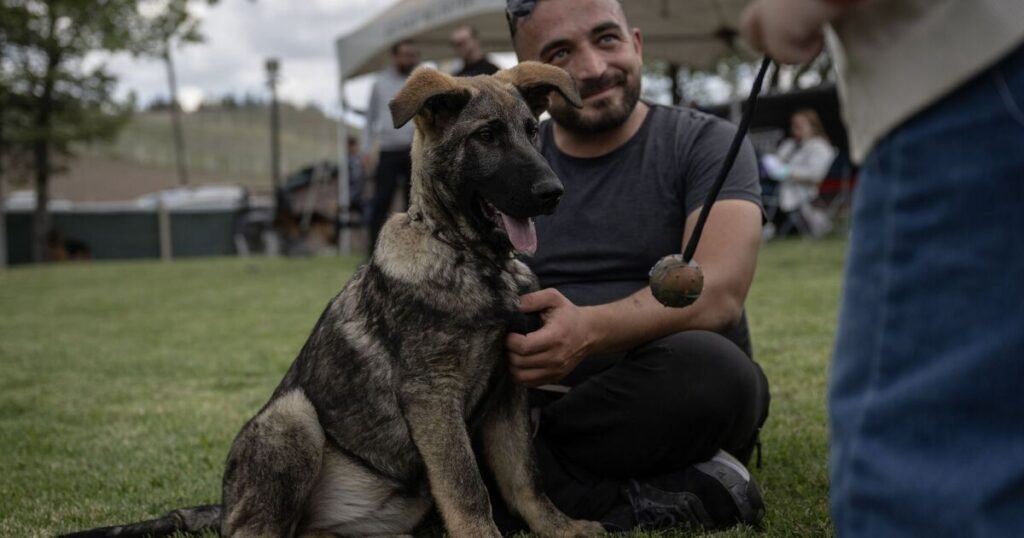
A dog training expert has shared five easy-to-follow steps for all dog owners that will make their beloved pup behave better. Adam, from Southend Dog Training, has racked up more than 40 million views across social media with his dog training tips, earning positive reviews from thousands of happy pet owners. The Southend Dog Training team offers online dog training courses through monthly subscriptions, beginning at £11.99, as well as home visits and pet food.
In his latest video, Adam promises to help you “see a better relationship between you and your dog,” with five simple instructions. The first of which, is the “art of attention” which he describes as being “very, very straightforward” for dog owners to exhibit at home.
“Before you give your dog anything fun or exciting — before going for walk, letting him off the lead, before putting their bowl down to feed them or giving them a treat — basically, before you give your dog anything they desire or want, you wait for eye contact.
“Once you have your dog’s attention, everything else you teach them is easier. All you have to do, guys, is wait. We don’t ask for them to look at us, we don’t ask them to ‘watch me,’ the reasoning being…you can force them to not look at you more.
“We want the dog to learn that eye contact gets them everything. It makes you more important — the centre of the dog’s universe. Once the dog is in the habit of looking at you to get what it wants, you can add in a ‘look at me’ command, and it will be more reliable.”
The second instruction is another easy concept to keep your dog on the lead both inside and outside of the house.
“So many instances occur when your dog runs over to something and you cannot stop it,” Adam explains, adding, “By keeping your dog on a lead inside and outside the house, you maintain that control/leverage. It means, if you want the dog off of something and it doesn’t understand, you can lead it away, conflict-free.
“You can also practice leading your dog around the house, making it more comfortable on that lead. It helps prevent your dog running out the front door, jumping all over your guests — you can pick up the lead, keep your dog next to you until it’s calm.”
Adam also recommends that you do not leave the lead on your pet when you’re not around for safety reasons but use a thin, lightweight lead so that the dog can drag it around unbothered when you are around to supervise.
“Number three, exercise — it sounds simple yet so many dogs are underexercised. If [your dog] is not getting enough exercise, all of that energy has to go somewhere — excessive barking, destructive behaviour and other general nuisance behaviours can often be traced back to a lack of exercise.
“Most healthy adult dogs need between one to two hours of exercise per day. Breeds like a Greyhound, maybe need a little less…breeds like a Dobermann, maybe a little more. But proper exercise is key to a happy, healthy dog.”
The trainer highlights the importance of both mental and physical stimulation for dogs, adding simple methods such as hiding toys or food.
Another tip from Adam, which follows on from exercise, stresses the importance of making your dog switch off with long periods of sleep.
Adam said: “So many dogs are not getting nearly enough [sleep]. When they come back from a walk, they’ll lie on the sofa, lie on the floor, but the second you go to a different room, it follows you.
“The dog is getting a lot of broken sleep. It can make you irritable, it can make you restless. First of all, follow point three, make sure your dog is getting enough exercise but then after exercise, we utilise crates or beds or spots on the sofa.
“After exercise, you want to crate your dog for a minimum of two hours. This will teach your dog over a period of time to achieve full decompression. Your dog will be much calmer.”
Dinnertime is emphasised as a prime time to try this method, to help with other unwanted habits your pet might have.
Adam’s final step in ensuring better behaviour from your pooch is the art of waiting. He explains: “Our inability to wait is why dogs will often have so many issues. Our inability to wait before we greet when we come into the house, or stroke the dog, give them something they want.
“Our inability to wait before the dog gets what it desires is why the dog will often exhibit unwanted behaviour. If your dog is jumping up and down and you open the door and it drags you through for a walk, if you had slowed down and waited a few minutes until the dog was calm, and then went for a walk, you’d see a noticeable difference.
“If your dog whines for attention, and you give it, your dog will exhibit these behaviours in order to get that attention [again]. But, if you wait until it’s silent, whether that’s five minutes or 10 minutes, and then give the dog what it wants, it will learn that silence gets what it wants.”
 Latest World Breaking News Online News Portal
Latest World Breaking News Online News Portal






